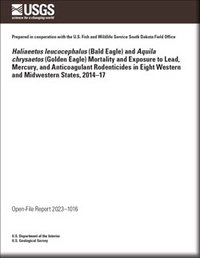Haliaeetus leucocephalus (Bald Eagle) and Aquila chrysaetos (Golden Eagle) Mortality and Exposure to Lead, Mercury, and Anticoagulant Rodenticides in Eight Western and Midwestern States, 2014–17
Links
- Document: Report (2.10 MB pdf) , HTML , XML
- Data Release: USGS data release - USGS National Wildlife Health Center necropsy and contaminant results for bald and golden eagles collected in 8 States from January 1, 2014, through December 31, 2017, to determine cause of illness/death and lead, mercury, and anticoagulant rodenticide exposure
- Download citation as: RIS | Dublin Core
Abstract
The U.S. Geological Survey National Wildlife Health Center measured environmental contaminants in Haliaeetus leucocephalus (bald eagles) and Aquila chrysaetos (golden eagles) to evaluate dietary exposure to lead, mercury, and anticoagulant rodenticides (AR), all of which were identified by U.S. Fish and Wildlife Service as a priority issue of concern for Mountain Prairie Region 6. Data were needed to inform U.S. Fish and Wildlife Service regional programs aimed at reducing exposure to these substances. Carcasses of bald eagles (n=172) and golden eagles (n=142) collected from North and South Dakota, Montana, Wyoming, Colorado, Utah, Nebraska, and Kansas between 2014 and 2017 were assessed for cause of death and liver lead, mercury, and AR level concentrations. Trauma, electrocution, and lead poisoning were the three leading causes of death, affecting 51 percent, 21 percent, and 20 percent of eagles, respectively. Trauma was the leading cause of death for both species, whereas lead poisoning was the second leading cause of death for bald eagles (31 percent) and was only diagnosed as the cause of death in 7 percent of golden eagles. Elevated lead concentrations within the range of subclinical or clinical poisoning (greater than [>] 2 milligrams per kilogram [mg/kg] wet weight) were present in 25 percent of eagles tested, including 36 percent of bald eagles and 11 percent of golden eagles. No association was detected among lead exposure and trauma, electrocution, or infectious disease. Mercury concentrations were considered high (>80 mg/kg dry weight) for only 2 percent of bald eagles and no golden eagles. Brodifacoum was the most common AR detected, present in 56 percent of eagles, including 70 percent of bald eagles and 39 percent of golden eagles; however, death was not directly attributed to AR toxicosis in any case. Results of this study provide baseline data on common causes of mortality and threats to eagles in Region 6 from lead, mercury, and rodenticide exposure and can be used to inform management decisions.
Suggested Citation
Bodenstein, B.L., Lankton, J.S., Russell, R.E., and Schwarz, M.S., 2023, Haliaeetus leucocephalus (bald eagle) and Aquila chrysaetos (golden eagle) mortality and exposure to lead, mercury, and anticoagulant rodenticides in eight western and midwestern States, 2014–17: U.S. Geological Survey Open-File Report 2023–1016, 23 p., https://doi.org/10.3133/ofr20231016.
ISSN: 2331-1258 (online)
Study Area
Table of Contents
- Acknowledgments
- Abstract
- Introduction
- Methods
- Mortality and Exposure Results
- Evaluation of Causes of Death and Contaminant Exposure
- Summary
- References Cited
| Publication type | Report |
|---|---|
| Publication Subtype | USGS Numbered Series |
| Title | Haliaeetus leucocephalus (bald eagle) and Aquila chrysaetos (golden eagle) mortality and exposure to lead, mercury, and anticoagulant rodenticides in eight western and midwestern States, 2014–17 |
| Series title | Open-File Report |
| Series number | 2023-1016 |
| DOI | 10.3133/ofr20231016 |
| Publication Date | April 19, 2023 |
| Year Published | 2023 |
| Language | English |
| Publisher | U.S. Geological Survey |
| Publisher location | Reston, VA |
| Contributing office(s) | National Wildlife Health Center |
| Description | Report: vii, 23 p.; Data Release |
| State | Colorado, Kansas, Montana, Nebraska, North Dakota, South Dakota, Utah, Wyoming |
| Online Only (Y/N) | Y |


